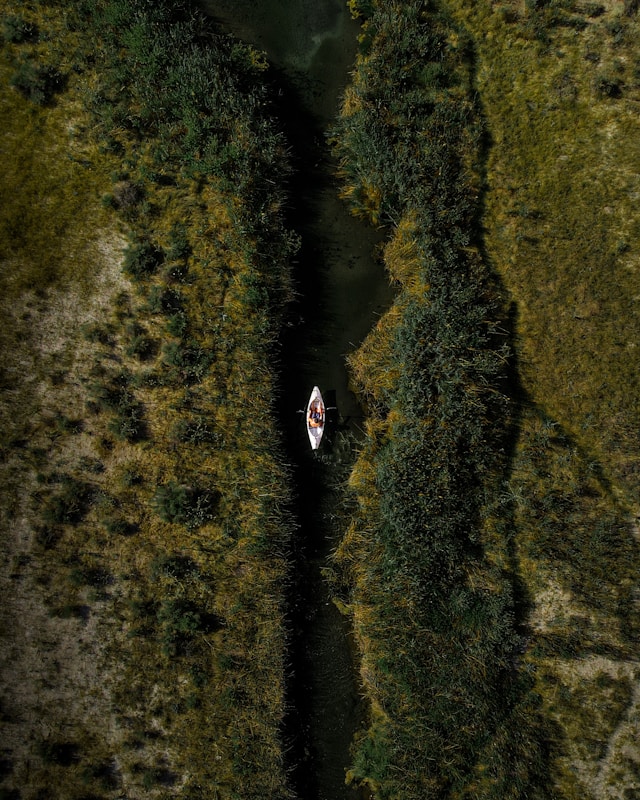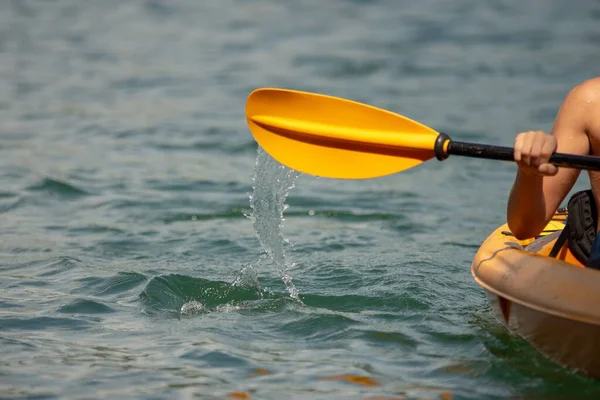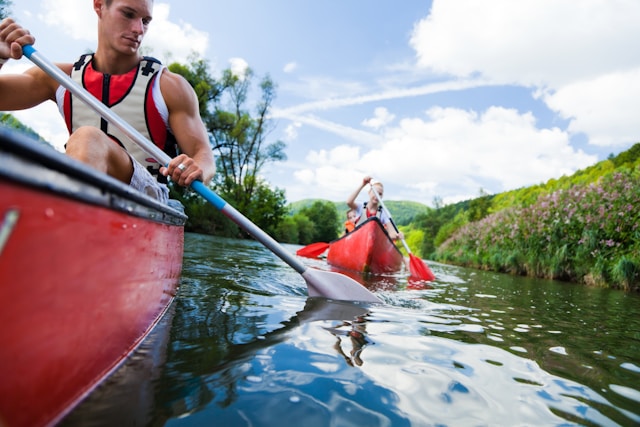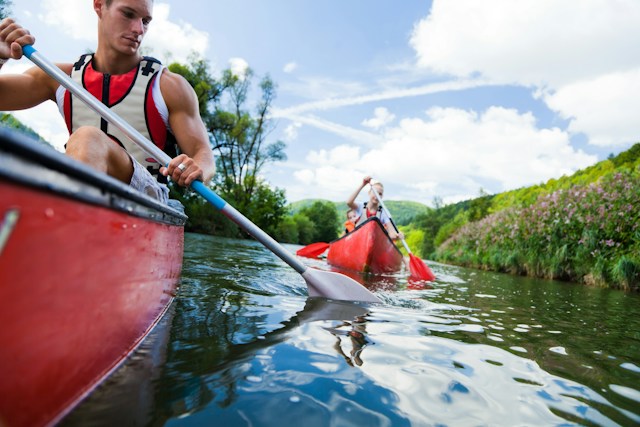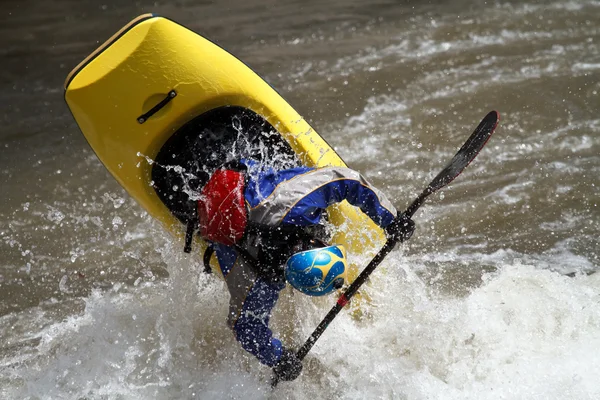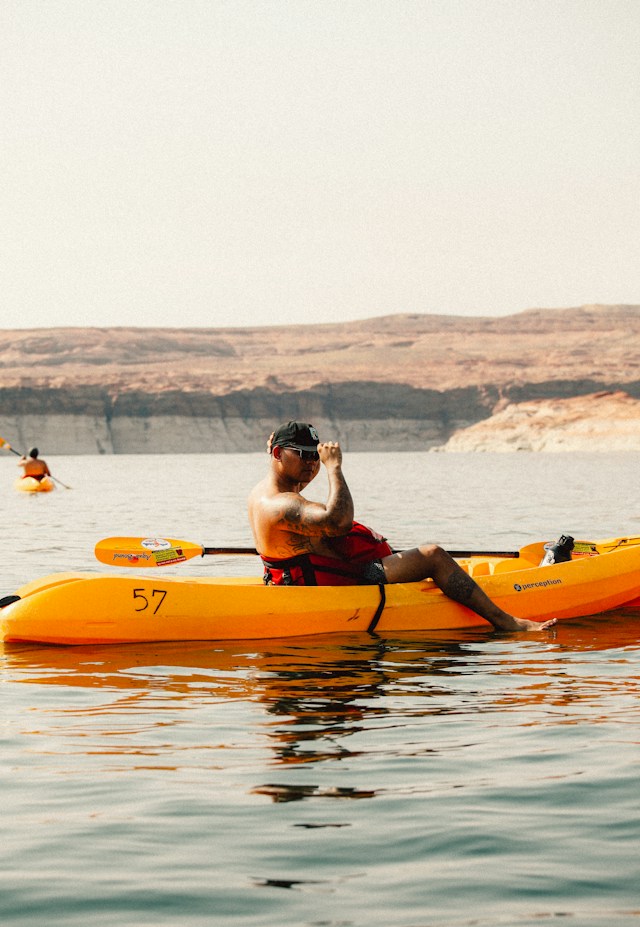How to Kayak at Night? A Simple Guide
Imagine this: The moon casts a silver path across the still water, the air is quiet except for the soft splash of your paddle…it’s a whole different world out there at night!
Kayaking under the stars is an experience like no other. But before you head out, there are a few things you need to know to keep it safe and fun.
How to Kayak at Night?
Think of this guide as your ticket to adventure. We’ll cover:
- Must-Haves: The lights and other gear that let you see and be seen on the water.
- Nighttime Know-How: How to find your way, even when it seems like there are no landmarks.
- Staying Safe: Simple rules to make sure your night paddle is an awesome one, not a scary one.
Ready to see your favorite kayaking spot in a whole new light? Let’s dive in!
Risks and Legalities of Night Kayaking
Before we talk about how awesome night kayaking is, let’s cover the serious stuff. Being out on the water at night comes with some extra risks you need to be aware of.
Here’s the deal:
- It’s DARK out there: Harder to see obstacles, other boats, etc. That’s why special lights are a must (more on that later!).
- The Rules: Different areas have different laws about kayaking at night. We’ll help you figure out what’s required where you plan to paddle.
- Be Prepared: Things can go wrong even with experienced kayakers. Knowing basic safety procedures is key.
Don’t worry, this isn’t meant to scare you off! Just a reminder that a little preparation makes all the difference.
Review State and Federal Regulations
We know rules aren’t the most fun part, but they matter! Every state (and sometimes even different lakes or rivers) have their own requirements for kayaking at night.
Usually, it’s stuff like:
- Lights: What kind you need and where to put them on your kayak.
- Other Gear: Some places make you carry a whistle, flares, etc.
- Where You Can Go: Certain areas might be off-limits after dark.
Don’t worry, it’s not hard to find this info. Websites for your state park system or local boating authorities are the best places to look. Better to check now than get in trouble later!
Identifying Common Hazards After Dark
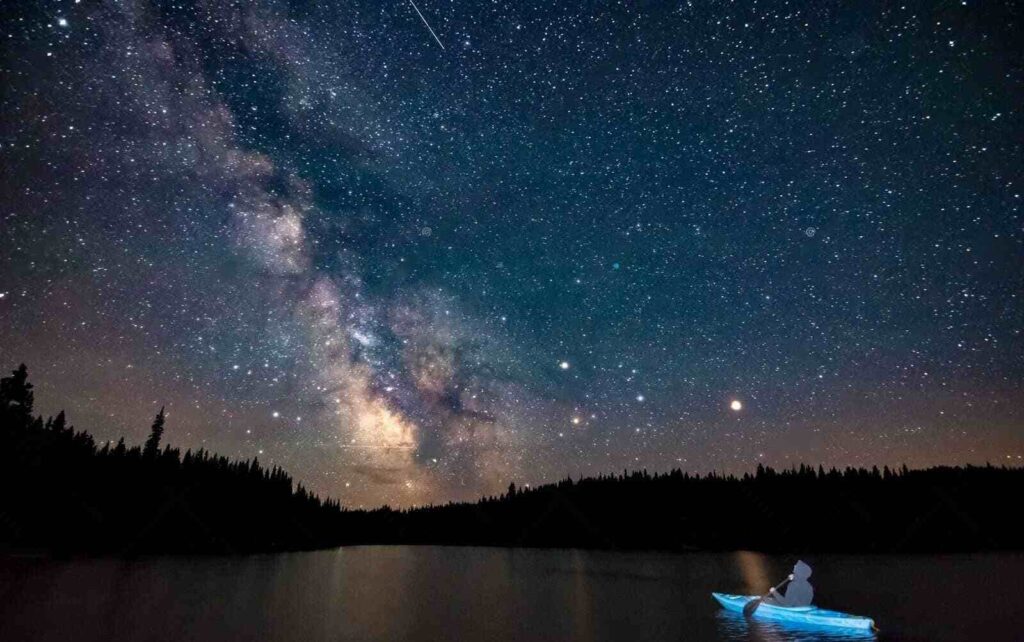
Navigating the water during nighttime poses unique challenges and risks.
It is essential to be aware of the common hazards encountered after dark, such as reduced visibility, unpredictable weather conditions, and increased boat traffic.
By recognizing and preparing for these hazards, you can mitigate the risks associated with night kayaking and ensure your safety on the water.
Legal Requirements for Lighting and Safety
Think of night kayaking gear like having superpowers! Here’s the essentials:
- Your Beacon: A bright white light that can be seen from all around. This tells other boaters “Hey, I’m here!” and helps prevent collisions.
- Extra Flash: Headlamps, glow sticks, etc., give you more visibility for paddling and finding things in your kayak.
- Safety First: Your lifejacket (PFD) is non-negotiable, day or night. Whistles or flares might also be required by law.
It’s not just about following rules – this stuff makes your paddle safer. Imagine trying to find your water bottle in the pitch dark, or another boat not seeing you until it’s too late…no thanks!
Preparing Your Kayak for Twilight Paddling
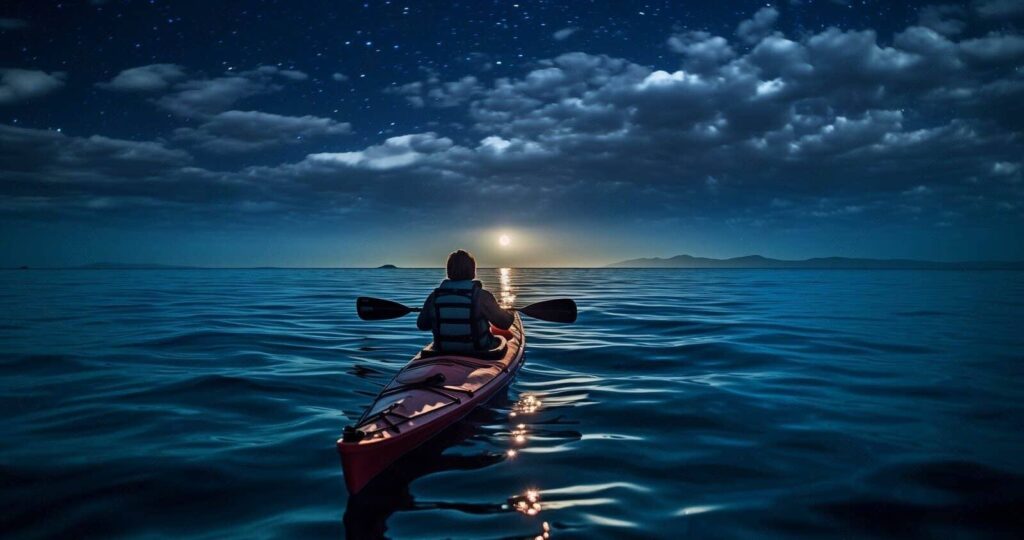
Give your kayak a quick checkup before heading out at night. It only takes a few minutes, but could make a huge difference! Here’s your checklist:
- Is Everything Working? Check your kayak for loose straps, broken parts, etc. Paddle in good shape? Lifejacket not ripped?
- Floating High & Dry: Make sure your kayak won’t sink if it flips. Most have sealed compartments, but it’s worth double-checking.
- Gear Check: Got your lights? (More on that in a bit!) Whistle? Anything else the rules in your area require?
Taking care of your stuff means you’re less likely to have a problem on the water. Who wants to paddle back in the dark with a broken seat? Not you!
Right Lights for Visibility and Safety
When kayaking at night, it’s crucial to have the right lights to ensure visibility and safety on the water.
In this section, we will explore the different types of lights that are essential for night kayaking, including white lights, reflective tapes, and emergency signaling options.
White Lights: A Legal and Practical Necessity
Think of your white light as sending a signal: “Kayaker over here! Please don’t run me over!” Motorboats, especially big ones, might not see you otherwise.
Here’s what to look for in a good kayak light:
- Bright & Steady: You want a light that really stands out in the darkness. LED lights are perfect for this.
- Waterproof: Duh! But seriously, make sure it’s designed for being on the water.
- Long-Lasting: Nobody wants their light dying halfway through their paddle. Check how many hours of use the batteries are good for.
Picking the right light gives you peace of mind and makes those bigger boats way more likely to see you.
Reflective Tapes and Their Importance
Think of reflective tape as your kayak’s glow-in-the-dark superpower! It bounces back the light from other boats, making you way easier to spot.
How to use it:
- Stick it on!: Slap strips of reflective tape along the sides of your kayak, and maybe a patch on the back too.
- Light me up!: Now, when a motorboat’s headlight hits your kayak, you’ll light up instead of blending into the darkness.
Safety and style! You can even find reflective tape in different colors if you want to get fancy.
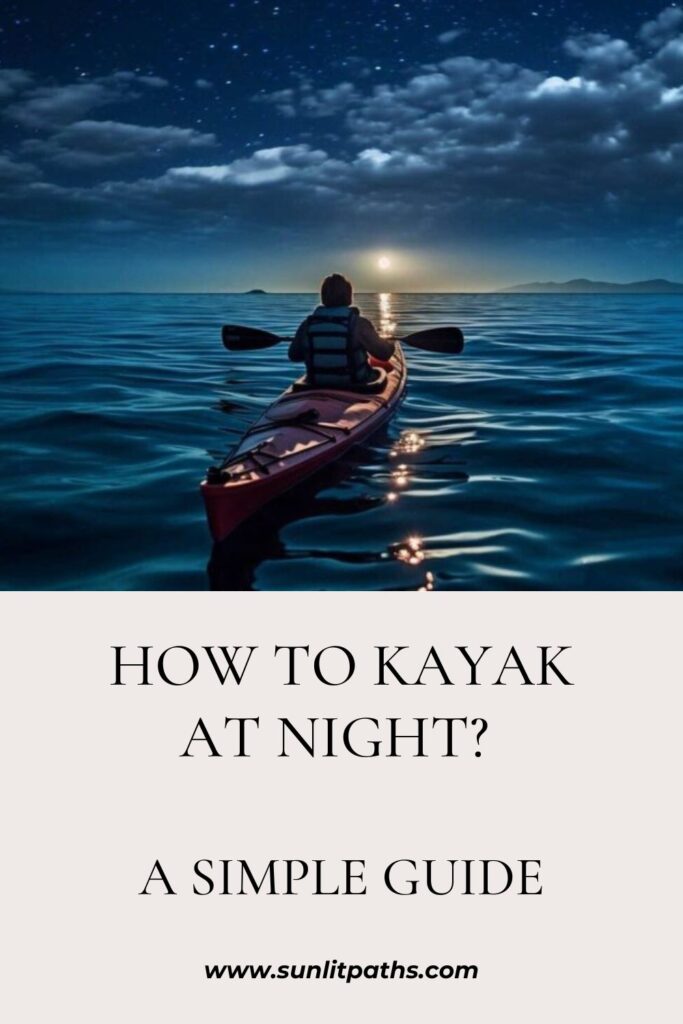
Emergency Signaling: Preparing for Worst-Case Scenarios
Hoping for the best, but preparing for anything – that’s the smart way to kayak, especially at night. Here’s your safety kit:
- Be Heard: Whistle or air horn blasts through the darkness way better than yelling.
- Extra Flash: Flares or a small signal mirror are good backups in case your batteries die (pick one, you probably won’t need both!)
- Know Your Stuff: Practice using your safety gear before you’re out on the water. No time to read instructions in an emergency!
Keep this stuff handy (in a waterproof bag is ideal!). The good news is, you probably won’t ever need it…but if you do, you’ll be so glad you have it.
How to Kayak at Night? Navigational Aids and Techniques
even if you know the lake or river well, it looks different at night! Here’s how to make sure you don’t get lost:
Tools of the Trade:
- Map & Compass: Old-school, but reliable! Waterproof versions exist.
- Phone GPS: Great if there’s cell service, but have a backup plan in case the battery dies.
- Headlamp: Lets you see your map, compass, etc., without juggling a flashlight.
Knowing Your Surroundings:
- Landmarks: Can you still spot familiar things on shore, even at night? That helps keep you oriented.
- Stars: If you’re in a really remote spot, learning a few basic constellations can help you find North.
We’ll get into more detail on how to use these tools later, but the key is being prepared!
Utilization of Compasses and GPS Devices
Think of a compass and GPS like your kayaking sidekicks! Here’s how they help you find your way:
Compass:
- Always Points North: Even in the dark, a compass shows you which direction you’re facing.
- Pair with a Map: Knowing where you are and where you want to go, plus your compass – that’s all you need to stay on course.
GPS:
- Your Digital Map: Shows your exact location, even if you can’t see the shore.
- Tracks Your Route: Cool to see where you’ve paddled after the fact, and can help you get back if needed.
Don’t be afraid of these tools! There are tons of simple “how-to” videos online, or ask someone at an outdoor store for tips.
Familiarization with Local Waterways
Think of studying the area beforehand like scouting out a hiking trail. You want to know where the big turns are, where it might get shallow, etc. Here’s how:
- Map Time: Even if you’ve paddled the area before, look at a map. It helps refresh your memory and you might spot things you never noticed in the daylight.
- Look for Landmarks: Big trees, buildings, anything that stands out even at night. These are your signposts when you can’t see as far.
- Know the Hazards: Are there shallow spots, areas with lots of boat traffic? Better to find out now than get an unpleasant surprise in the dark!
A little bit of planning goes a long way. You’ll feel more confident on the water, and that makes for a more enjoyable paddle.
Staying Oriented: Using Landmarks and Constellations
Forget fancy gadgets for a minute – your eyes are amazing navigation tools too! Here’s how to use them:
Landmarks:
- Daytime Scouting: Notice things like that one giant tree, or the house with the weird roof. These stand out even at night.
- Lights on Shore: Dock lights, streetlights, etc. can help you figure out where you are in relation to land.
Star Power:
- The Basics: Learning to find the North Star (Polaris) is a cool skill, and surprisingly easy!
- Constellations: Once you know a few major constellations, it’s easier to keep track of which direction you’re facing.
Think of it like learning to spot different types of trees in a forest. The more you practice, the better you get at recognizing these natural “signposts”.
Gear Checklist for Nocturnal Kayaking Adventures
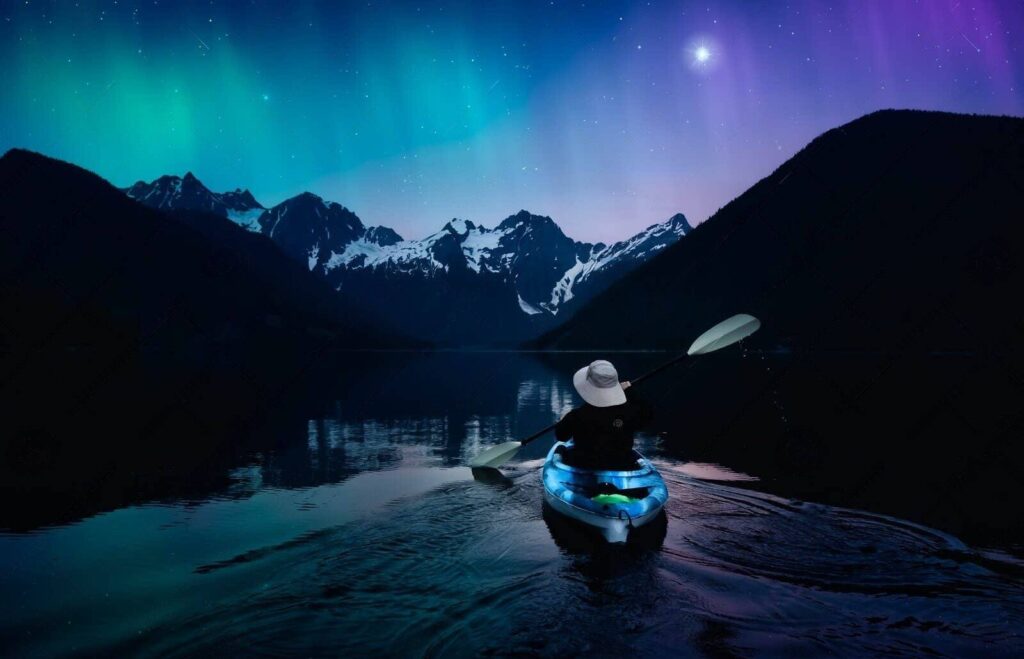
The Must-Haves:
- Lifejacket (PFD): It’s the law, and way smarter than not wearing one. Make sure yours fits right!
- Lights: Headlamp (so you can see stuff) and the ones your kayak needs to be legal. Check the batteries!
- Phone/Radio: Only if it’ll get reception where you’re paddling. Waterproof case is non-negotiable.
Safety Extras:
- Whistle: Easier to use than yelling if you need help.
- First Aid Kit: Just the basics – bandages, wipes, etc.
- Repair Kit: Duct tape can fix SO many problems!
Comfort & Convenience:
- Dry Bag: Keeps your phone, snacks, extra clothes from getting soaked.
- Warm Layers: Even in summer, it can get chilly on the water at night.
- Water & Snacks: Don’t get hangry out there!
Remember, check the weather and the rules for the area you’ll be paddling. You might need to add a few things to this list!
What to Wear: Dressing for the Occasion and Conditions
When embarking on a night kayaking adventure, it’s crucial to dress appropriately for the occasion and the conditions you’ll encounter. Here are some key considerations to keep in mind:
Dress in Layers to Adapt to Temperature Changes
Think of dressing for night kayaking like an onion – all about layers! Here’s why:
Layer 1: Next to Skin
- Goal: Stay dry, even if you sweat. Look for “wicking” fabrics, NOT cotton.
Layer 2: Warmth
- Fleece is your friend! Lightweight, but good insulation. A zip-up lets you adjust easily.
- Wool: Another great option, especially if it might get really damp.
Layer 3: Weather Shield
- Waterproof & Windproof Jacket: This goes on top to keep out rain, spray, and chilly breezes.
Pro Tips:
- Hat & Gloves: Easy to lose heat from your head and hands!
- Avoid bulky clothes:
Utilizing Personal Flotation Devices When Visibility Is Reduced
Your lifejacket (PFD) is your #1 piece of safety gear, day or night! But here’s why it matters even more in the dark:
- Hard to Rescue What You Can’t See: If you fall in, another boat might not spot you without a brightly-colored PFD.
- Comfort is Key: You’ll actually WEAR a PFD that fits well and doesn’t get in your way while paddling.
- Look for Extras: Some PFDs have pockets for your whistle, lights, etc., or have reflective patches built-in.
Don’t think of your PFD as a hassle – think of it as your kayaking superpower! It lets you have way more fun, knowing you’re safer out there.
Enhancing Gear with Reflective and Illuminating Components
Think of yourself as a glow-in-the-dark superhero on the water! Here’s how to gear up:
- Shine Bright:
- Kayak: Reflective tape along the sides makes you easier to spot.
- Paddle: A few strips on your paddle blade catch the light when you move.
- You!: Slap some reflective stickers on your lifejacket or helmet.
- Red Light Special: Using a red light helps you see better at night. Headlamps often have this as an option.
- Extra Flash: Keep a regular flashlight or headlamp handy for emergencies, or in case your red light dies.
It’s amazing how much these little things help! Think of it as adding cool glowing stripes to your superhero costume – safety AND style points!
Related Content
- Can You Kayak While Pregnant? : A Simple Guide
- How To Use A Trolling Motor On A Kayak?
- Can A Kayak Sink? A Comprehensive Guide
- What Is The Difference Between A Kayak And A Canoe?
Planning Your Route: Importance of Pre-Trip Strategies
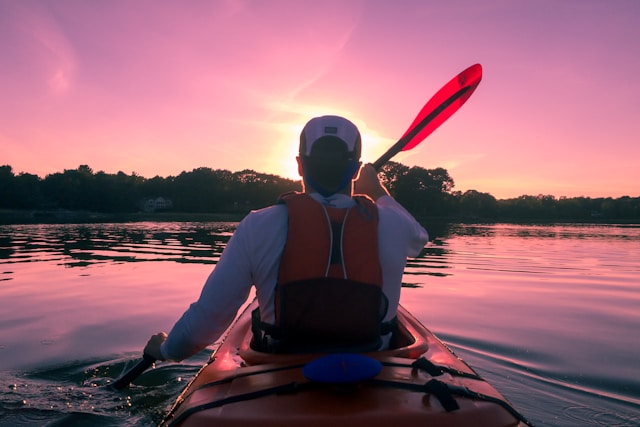
When it comes to night kayaking, planning your route is crucial for a safe and enjoyable experience.
By implementing pre-trip strategies, you can ensure a smooth journey and minimize potential risks. Here’s what you need to consider:
Consulting Weather and Tide Reports
Imagine heading out to paddle, and the wind suddenly picks up, turning your relaxing trip into a battle! Not fun. That’s why checking the weather is key.
Here’s what to look for:
- Wind Check: Is it calm, or gusty enough to give you trouble? Wind direction matters too (paddling into it is way harder!)
- Water Conditions: Tides (if you’re on the coast) and water temperature are important. Big waves are no joke, even in a kayak.
- Don’t Forget the Forecast: Will conditions stay the same all night, or is there a storm coming in?
Where to Find Info:
- Weather Apps/Websites: These give the basics, but…
- Local Knowledge is Best: Marinas, bait shops, etc. know the area and can tell you if the forecast is usually accurate.
Marking Safe Rest Spots and Emergency Exits
Think of your night paddle like a road trip. You wouldn’t drive for hours without planning a few rest stops, right? Same goes for kayaking!
Here’s why it matters:
- Recharge Time: Paddling takes energy, especially in the dark. Plan to pull over every so often to stretch, have a snack, and relax.
- Spot Check: Chance to make sure your gear’s okay, you’re not too cold, etc. Better to catch problems early!
- Peace of Mind: Knowing where you could get out of your kayak in an emergency helps you feel less stressed.
When picking your route, look for spots like:
- Beaches or Calm Shorelines: Easy to pull your kayak up.
- Docks (if allowed): Nice and stable, but check the rules first.
Communication and Check-ins: Sharing Your Float Plan
Think of a float plan like telling your friend where you’re going for a hike and when you’ll be back. Same idea for kayaking, especially at night!
Here’s what to tell them:
- Where: The exact place you’re putting your kayak in the water, and where you plan to take it out.
- When: What time you’re leaving, and when you expect to be back.
- Gear Check: The kind of kayak you’re in, and a description of you (what you’re wearing, etc.)
Why it matters:
- If You’re Late: Your friend knows to start checking in on you, and can get help if needed.
- Peace of Mind: You can relax and enjoy your paddle, knowing someone’s got your back on shore.
Exploring the Serene Realm: The Magic of Nighttime on the Water
Kayaking at night is a whole different world. It’s quiet, the stars are crazy bright…it feels special, and a little bit adventurous.
Think about it:
- Amazing Views: With no city lights to wash them out, you can see SO many stars. Sometimes, they even reflect in the water.
- Wildlife Watching: Animals that hide during the day often come out at night. You might hear new sounds, or even see something cool!
- Super Relaxing: It’s just you, the water, and the sounds of nature. The perfect way to escape stress and clear your head.
If you’re the type who loves exploring, night kayaking is for you. It’s like discovering a hidden side of a place you thought you knew.
Safety Procedures and Emergency Protocols
Kayaking at night is awesome, but being safe is the #1 priority. Here’s a few easy things you can do:
- Be Seen: Make sure your kayak has the right lights. This is how other boats on the water know you’re there!
- Know How To Get Back In: If you fall out, can you get back in your kayak by yourself? Practice this beforehand in a safe spot.
- Tell Someone Your Plan: Where are you paddling, and when will you be back? Tell a friend or family member before you go.
- Gear Up: Lifejacket (always wear it!), whistle, flashlight, and a little first aid kit – these could save the day if something goes wrong.
It might sound like a lot, but most of this is simple stuff. Taking a little time to prepare gives you way more peace of mind out on the water!
Conclusion
Night kayaking is amazing, but let’s talk about doing it safely. Here’s the most important stuff:
- Lights & Laws: Every place has rules about lights on kayaks, and what else you might need for paddling at night. Look that up first!
- Be Seen, Stay Safe: Your white light tells other boats you’re there. Whistle is good backup in case something goes wrong. Always wear your lifejacket.
- Know Where You’re Going: Even a familiar lake looks different in the dark. Study maps beforehand, and have a compass or GPS as backup.
Night kayaking is awesome once you have these basics down. The rest is all about having fun out there!

